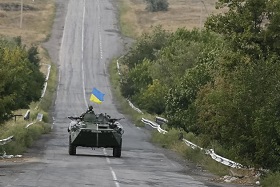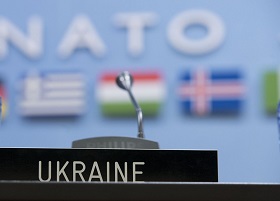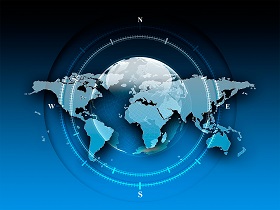Ukraine: Non-Bloc Transit
Ukraine's Prime Minister Arseny Yatseniuk at
a joint news conference with NATO Secretary
General Jens Stoltenberg. December 15, 2014
In
Login if you are already registered
(no votes) |
(0 votes) |
PhD in Economics, Head of the European Security Department RAS Institute of Europe
On December 18, 2014 President of Ukraine Petro Poroshenko submitted a draft law to Verkhovna Rada entitled “On Amending Certain Laws of Ukraine on Ukraine's refusal to implement the policy of non-alignment,” which was adopted on December 23 (303 deputies voted for it, 9 voted against, and 2 abstained). Formally, the law envisions the removal of legal barriers to the county’s integration into NATO. In fact, it concludes the period of Viktor Yanukovych’s “anti-NATO revisionism” and confirms membership in NATO as a priority foreign policy objective set forth by the “orange” leadership.
On December 18, 2014 President of Ukraine Petro Poroshenko submitted a draft law to Verkhovna Rada entitled “On Amending Certain Laws of Ukraine on Ukraine's refusal to implement the policy of non-alignment,” which was adopted on December 23 (303 deputies voted for it, 9 voted against, and 2 abstained). Formally, the law envisions the removal of legal barriers to the county’s integration into NATO. In fact, it concludes the period of Viktor Yanukovych’s “anti-NATO revisionism” and confirms membership in NATO as a priority foreign policy objective set forth by the “orange” leadership.
Amidst the ongoing conflict in Ukraine, the law creates new risks for the country itself and for external participants of European security, which is facing a serious systemic crisis. This engenders difficult dilemmas in the future related to the issues of Ukraine's relations with NATO, including the prospect of membership and the respective reconfiguration of Russian-European and international relations.
Will Ukraine become a member of NATO?
The issue of Ukraine’s joining NATO has been put on the European security agenda again. In April 2008, the Bucharest Summit of the Alliance stated that it was “agreed that Ukraine (and Georgia) will become a member of NATO.” However, the Bucharest maxim has now changed dramatically. At first, this was a just form of political and diplomatic refusal for Ukraine, but with a promise to review the issue some time later. Now, on the contrary, the Bucharest wording is regarded as the fundamental basis for progress towards membership not only by Kiev but NATO as well, which deliberately views enhancing its partnership with Ukraine through the prism of the declared membership perspective.
The Bucharest decision has been thus transformed from the previous excuse to a “memorandum of understanding.” Common sense and pragmatism of those who have previously opposed Ukraine’s membership in NATO are now interpreted by the US and its consistent (neo-European) supporters as proven errors and unreasonable concessions to “aggressive” Russia, which is perceived by Moscow as an indicator of the weakness of the West and a sign for attack. The formula that “Ukraine will become a member of NATO” no longer reflects s political and diplomatic compromise with Moscow, which has been revoked by the Ukrainian crisis and the acute Russian-Western conflict. The emphasis in this formula has been put on the word “will”, while the implied “someday” has been replaced by the newly relevant “how and when.”
The new Kiev authorities pursued these particular changes when they placed a stake on gaining “protection from Russia” through the support of the West, including political and military instruments, in the context of the Crimean events in March 2014. The main directions of Ukraine’s defense and security promotion were identified by NATO in March 2014 [1] and later confirmed by the decisions of the Wales Summit in September 2014. Having received such support and having tried to make maximum use out of the western “sanctions' logic” and of Russia’s containment momentum, Kiev decided to make the issue of NATO membership genuine. December 2, 2014 happened to be the “right moment,” as on that day the Commission Ukraine-NATO (CUN) held its session and the Verkhovna Rada approved the coalition Government of Ukraine, which declared integration with NATO its major goal. This testified to the seriousness of Kiev’s and Brussels’ intentions, while the latter’s greeting of the new Ukrainian government indicated the recognition of its political choice and, therefore, legitimized Ukraine’s bid for membership.
How feasible is Ukraine’s membership in NATO?
The emphasis in this formula has been put on the word “will”, while the implied “someday” has been replaced by the newly relevant “how and when.”
On the eve of the CUN meeting on December 2, 2014, the West made it clear that it had reconsidered its position. «The issue of Ukraine’s membership in NATO is not on the agenda. And I do not see Ukraine on the way to NATO… I advocate full clarity on this issue,” said German Foreign Minister Frank-Walter Steinmeier. “Others, perhaps, prefer to be more reserved in their public statements, but I know that that many think the way I do.” NATO Secretary General Jens Stoltenberg diplomatically recommended that Ukrainian partners refrain from raising the issue of official membership, “We will treat with respect the decision of Ukraine to apply, if it is made. The same way we will respect the decision not to apply”.
Kiev, unable to join the NATO Membership Action Plan (MAP) due to the conflict, is ready to comply with the relevant conditions in other formats outside its framework.
Kiev understood the message perfectly well, and Ukrainian Prime Minister Arseniy Yatsenyuk acknowledged it to be premature to apply for membership at the meeting with Jens Stoltenberg on December 15, 2014 [1]. A. Yatsenyuk had learned the history lesson, when the official declaration of political will for membership made by the “orange” government of Ukraine (and signed by him as Chairman of Verkhovna Rada together with President Viktor Yushchenko and Prime Minister Yulia Tymoshenko) was rebuffed by NATO.
Although Kiev could hardly expect more at the present moment, it seeks “to program future” (in which Ukraine should be part of the geopolitical West) and transfer the Bucharest formula into more practical political parameters. In addition, NATO addressed the trial balloon which made it possible not only to “test the waters,” but also to “fit” the programs of enhanced cooperation between Ukraine and NATO in the move to advance its membership (given that Ukraine has not been yet invited to the NATO Membership Action Plan).
Ukrainian Prime Minister Yatsenyuk confirmed that the new leadership of Ukraine “has one joint position over all national security and defense issues." This is a joint decision “to eliminate the so-called non-bloc status that was granted to Russia by then President Yanukovych” as the first step.
After that Ukraine should focus on a kind of internal road map to prepare for membership. “The second step is to implement reforms that are needed in the security sector, in politics, in the economy, in judicial matters to meet all standards and criteria that apply to NATO member states. The third step – to conduct, in accordance with Ukrainian legislation, the referendum on the future of membership; and the final, fourth step – if that plan is executed, Ukraine will be ready to join the alliance.” [2]
This means that Ukraine under no circumstances wants to provoke Brussels with its (unrealistic) insistence, but is positioning itself as a future member of NATO with more certainty and seeks to make it the foundation of the interaction with the Alliance. In practical terms, this means that Kiev, unable to join the NATO Membership Action Plan (MAP) due to the conflict, is ready to comply with the relevant conditions in other formats outside its framework. Since an invitation to the MAP does not guarantee quick accession in any case, Ukraine could well approach this goal without the MAP, having prepared in advance for the quick passage of the formal procedures for joining NATO as the political situation makes this possible. For Ukraine, this is a kind of common-law marriage in expectation of the marriage contract. And NATO is striving to strengthen ties without yet making any substantial commitments.
Civil marriage: a joint household
For Ukraine, this is a kind of common-law marriage in expectation of the marriage contract. And NATO is striving to strengthen ties without yet making any substantial commitments.
NATO has confirmed its course of solidarity with the participating countries in promoting a Distinctive Partnership with Ukraine in all spheres, including greater joint military activity and exercises. “These efforts are designed to enhance Ukraine's ability to provide for its own security” (implying from the “Russian threat”) [3].
Plans for cooperation between Ukraine and NATO are being implemented and the appropriate advisory, practical and logistical support from the Alliance is rendered in accordance with the Annual National Program of Ukraine-NATO for 2015 and the Roadmap that is designed to deepen interoperability between the Armed Forces of Ukraine and NATO for 2015-2016 years. Programs of direct assistance to Ukraine by NATO have been launched through the trust funds that involve 26 countries of the Alliance. Three trusts are aimed at promoting military reforms, improving the logistics and standardization of the Armed Forces of Ukraine, modernizing communication systems and fighting against cybercrime.
“Electronic” cooperation with Ukraine through cybersecurity channels is obviously of particular interest for NATO.
Given that NATO as an organization cannot make direct deliveries of weapons and military equipment to any partner state, the Alliance calls on member states to enhance military-technical assistance to Ukraine on a bilateral basis. At the meeting with Arseniy Yatsenyuk on December 15, 2014 NATO Secretary General Jens Stoltenberg expressed satisfaction with the substantive consultations between Ukraine and some member-countries on increased military and technical assistance, including the assortment expansion of the military equipment. On December 18, 2014 US President Barack Obama signed the Ukraine Freedom Support Act that “authorizes the President to provide a total of $350 million in defense articles, services and training to assist the government of Ukraine in reestablishing sovereignty over the next three years.”
At the same time, there are significant limitations of the partnership capability of Ukraine itself, caused by the problems of military-technical interoperability and standards as well as great technical complexity and costs of operation and maintenance of NATO weapons systems and military equipment, not to mention the financial support of rapprochement with NATO.
In view of this, the main focus is likely to be placed on assisting Ukraine’s transition to NATO standards and on promoting the interoperability of the armed forces. This, in turn, means that Ukraine will gradually transfer its armed forces over to NATO standards in the field of academic and combat training and technical re-equipment of the armed forces with weaponry and military hardware from NATO countries. Given the key importance of Ukraine and the “Wales” areas of military-political transformation and operational planning, NATO will step up its efforts to involve Ukraine in carrying out exercises and joint activities in academic and combat training on its territory.
Ukraine proposes to regard its Euro-Atlantic vector not as a free choice of defense systems in the context of NATO’s “open door policy”, but as an inevitable result of the aggravating continental conflict.
Along with “advisory assistance,” NATO and its member countries will continue targeted training of Ukraine’s junior command personnel as well as commanders who will eventually occupy leading positions in the army. According to retired Polish General Bohuslav Patseka, head of the Advisory Group of NATO military reform education in Ukraine, changing the standards in education and combat training of the Ukrainian Army will take 3-5 years, and a visible effect can be expected in 5-10 years.
The test of time
A five-year period seems to be the minimum “technical” term for Ukraine to reach the level of standards that allows for qualifying for NATO membership, provided that other criteria (financial, economic, legal, public administration, etc.) are met. Signing a bill repealing Ukraine’s non-aligned status, Petro Poroshenko confirmed that Ukraine would need a long time to meet the NATO membership criteria. “I think it will take us three years to finish this work,” he said. (It is indicative that although approximately the same period of time was specified after the Orange Revolution, Ukraine has failed to make significant progress).
However, the issue of Ukraine's membership in NATO has little to do with the country’s technical readiness and depends largely on the political environment. The progress depends on the resolution of the conflict in Ukraine itself and the future content of Russian-Western relations.

Vostock Photo
Igor Istomin:
The United States’ New Role in
the Ukraine Crisis: Pros and Cons for Russia
There is a growing understanding that the current crisis of the European system is substantive and therefore long-term. Following his visit to Moscow, on November 30, 2014, German Foreign Minister Frank-Walter Steinmeier noted a high probability of a prolonged conflict between the West and Russia. Moreover, he recognized that the situation was not only extremely dangerous, but the worst-case scenario could unfold.
The failure of all attempts to de-escalate the conflict, including the Minsk peace agreement, necessitates proceeding from these negative scenarios, namely a long-term conflict with the prospect of escalation, in military-political terms as well.
Therefore, the policy of the West (NATO) will be aimed at promoting Ukraine’s position as a partner and ally and at the development of its defensive capacity. NATO's defense planning, the foundation of which has again become collective defense (from the “Russian threat”), presumes the deployment of forward-based forces and facilities near the Russian border, and in this regard, Ukraine is inevitably assessed in terms of being a potential theater.
NATO military activity with regards to reforming and supporting Ukraine’s armed forces will undoubtedly increase. Taking into account both domestic and economic constraints, it is hard to say if Ukraine itself will be able to become a “true partner.” But the rapprochement with NATO is sure to be maintained as a priority state goal, including the allocation of resources. As stated in the explanatory note of President Poroshenko to the Law on the Abolition of the Non-Aligned Policy of Ukraine, “the fact that Ukraine has been located in the grey “buffer” zone between the powerful collective defense systems for a long time is an additional challenge for the country”.
This means that Ukraine, aware of the danger of the current conflict “between the two defense systems,” has made its choice and is ready to shape its policy as a front zone, rather than a buffer. At the first briefing after his appointment Secretary of the National Security and Defense Council of Ukraine Oleksandr Turchynov said: Russia may begin a full-scale continental war at any time.
If earlier the issue of Ukraine's membership in NATO was considered the line that could not possibly be stepped over in relations between Russia and the West, now there is the “Ukrainian frontier.”
In other words, Ukraine proposes to regard its Euro-Atlantic vector not as a free choice of defense systems in the context of NATO’s “open door policy”, but as an inevitable result of the aggravating continental conflict. It is assumed that the West, becoming increasingly involved in the conflict with Russia over Ukraine, will be finally forced to protect the latter not only by imposing sanctions, but through its instruments of collective guarantees. However, this extrapolation logic, on the contrary, just diminishes the chances of Ukraine of joining NATO. Both the West and Russia understand the catastrophic nature of military confrontation scenarios in Europe. Trying to avoid an escalation of military-political confrontation with Russia, NATO is showing certain restraint in developing practical partnership with Ukraine. Despite Kiev’s accusations of an undeclared war waged against Ukraine, Russia is trying to promote the political settlement of the conflict.
However, if earlier the issue of Ukraine's membership in NATO was considered the line that could not possibly be stepped over in relations between Russia and the West, now there is the “Ukrainian frontier.” The case in question is no longer about the future, as Sergei Lavrov warned in 2008, but a sharp deterioration of Russian “relations with the Alliance, with its leading members and with our neighbors”, and scenarios for a military confrontation in Europe. The problem of Ukraine’s official accession to NATO has ceased to be a starting point for future relations between Russia and the West; it is rather a derivative of the future of these relations. The outcome will depend on the ability to get out of a new Cold War paradigm and of the “programmed future.” In this future, Ukraine sees itself as a member of NATO in confrontation with Russia, while the latter perceives Ukraine virtually as a future member of the Alliance, which regards Kiev as a “ready for anything” ally and Ukraine – as a line of defense.
1. A strong NATO in a changed world. Speech by NATO Secretary General Anders Fogh Rasmussen at the ''Brussels Forum'', 21 Mar. 2014. // NATO official site (http://www.nato.int/cps/en/natolive/opinions_108215.htm?selectedLocale=en).
2. Joint Press Point with NATO Secretary General Jens Stoltenberg and the Prime Minister of Ukraine, Arseniy Yatsenyuk, 15 Dec. 2014 (http://www.nato.int/cps/en/natohq/opinions_116040.htm).
3. Wales Summit Declaration. Issued by the Heads of State and Government participating in the meeting of the North Atlantic Council in Wales (http://www.nato.int/cps/ru/natohq/official_texts_112964.htm?selectedLocale=en).
(no votes) |
(0 votes) |







